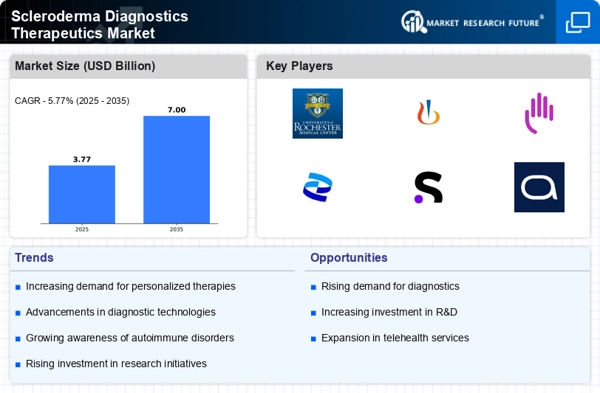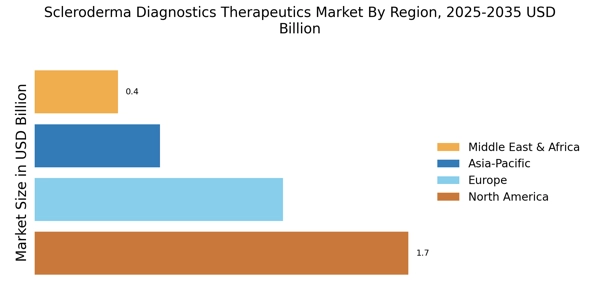Rising Prevalence of Scleroderma
The increasing incidence of scleroderma is a pivotal driver for the Scleroderma Diagnostics Therapeutics Market. Recent estimates suggest that scleroderma affects approximately 300,000 individuals in the United States alone, with a notable rise in cases reported in various demographics. This growing prevalence necessitates enhanced diagnostic tools and therapeutic options, thereby propelling market growth. As awareness of the disease expands, healthcare providers are more likely to seek advanced diagnostic solutions, which in turn stimulates demand for innovative therapeutics. The rising number of patients underscores the urgent need for effective management strategies, further driving investments in research and development within the Scleroderma Diagnostics Therapeutics Market.
Advancements in Biomarker Research
Recent advancements in biomarker research are significantly influencing the Scleroderma Diagnostics Therapeutics Market. The identification of specific biomarkers associated with scleroderma has the potential to revolutionize diagnostic processes, allowing for earlier and more accurate detection of the disease. This progress not only enhances patient outcomes but also encourages pharmaceutical companies to invest in targeted therapies. As the understanding of scleroderma's pathophysiology deepens, the development of biomarker-driven diagnostics is likely to expand, leading to a more personalized approach in treatment. Consequently, the integration of biomarker research into clinical practice is expected to drive growth in the Scleroderma Diagnostics Therapeutics Market.
Growing Awareness and Education Initiatives
The rise in awareness and education initiatives surrounding scleroderma is significantly impacting the Scleroderma Diagnostics Therapeutics Market. Various organizations and advocacy groups are actively working to educate both healthcare professionals and the public about the disease, its symptoms, and the importance of early diagnosis. This heightened awareness is likely to lead to increased patient referrals for diagnostic testing and subsequent therapeutic interventions. Furthermore, as more individuals become informed about scleroderma, the demand for specialized care and innovative treatment options is expected to grow. Consequently, these educational efforts are poised to drive market expansion within the Scleroderma Diagnostics Therapeutics Market.
Integration of Telemedicine in Patient Care
The integration of telemedicine into patient care is emerging as a significant driver for the Scleroderma Diagnostics Therapeutics Market. Telehealth solutions facilitate remote consultations, enabling patients to access specialized care without geographical constraints. This is particularly beneficial for individuals with scleroderma, who may face mobility challenges. The convenience of telemedicine encourages more patients to seek diagnostic evaluations and therapeutic options, thereby increasing market demand. Additionally, the use of digital platforms for monitoring disease progression and treatment efficacy is likely to enhance patient engagement and adherence to therapy. As telemedicine continues to evolve, its role in the Scleroderma Diagnostics Therapeutics Market is expected to expand.
Increased Investment in Research and Development
The surge in investment for research and development in the field of scleroderma is a crucial driver for the Scleroderma Diagnostics Therapeutics Market. Pharmaceutical companies and research institutions are allocating substantial resources to explore novel therapeutic options and improve diagnostic methodologies. This trend is evidenced by the growing number of clinical trials focused on scleroderma treatments, which have increased by over 30% in recent years. Such investments not only foster innovation but also enhance the overall understanding of the disease, paving the way for more effective therapies. As a result, the influx of funding into R&D is likely to catalyze advancements within the Scleroderma Diagnostics Therapeutics Market.


















Leave a Comment